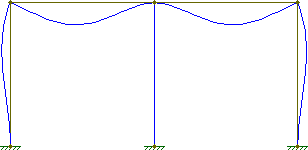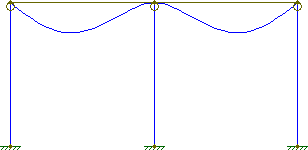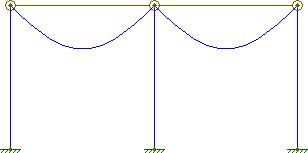I believe you have chosen a poor reference. Indeed, that link has absolutely nothing to do with structural analysis, but rather a specific implementation in steel structures.
A pinned support is a boundary condition which restricts all displacements but allows the structure to rotate.
A hinge (more formally, an internal hinge), on the other hand, is a description of the structure's behavior. Specifically, it removes the rotation compatibility between bars around a node (between all bars or a subset of them), thereby increasing the structure's degrees of freedom.
For a more visual demonstration of the difference, here's a structure with four pinned supports, along with its deformed configuration under the effect of a uniform load. You'll notice that the supports allow the structure to rotate around them, however one beam's inclination at a given node must be equal to the inclination of the neighboring beam on the same node, meaning there may be no discontinuity in the derivative of the deflection at the support (compatibility of rotations).

And now two variations on the same structure with the same loading, but with an internal hinge at different locations.

In this case, an internal hinge is placed on the same position as one of the supports. This removes the compatibility of rotations around that node, leading to a clear discontinuity in the derivative of the deflection around that support.

Now the hinge is placed in the middle of the central span, leading to a clear discontinuity in the derivative of the deflection at that point.
Hinges can also be placed to just one side of a node. For instance, look at the deflection of this frame under a uniform vertical load and a concentrated horizontal load.

The columns and beams all maintain their original perpendicularity. Specifically at the central column, notice that the beams maintain their angular compatibility (no discontinuity in the derivative of the deflection).
If, however, we add hinges to the tops of the columns:

The beams and columns no longer remain perpendicular in their deflected state. The beams over the central column, however, maintain their angular compatibility.
If, however, the nodes were fully hinged, then each span would behave independently like a simply-supported beam:

In the direct stiffness method, the fundamental equation is
$$\{q\}=K\{d\}$$
A pinned support defines the contents of $\{d\}$, by setting the degrees of freedom of the given node to $(d_x, d_y, \theta) = (0, 0, \theta)$ (in the case of a 2D structure). An internal hinge, on the other hand, increases the dimensions of the calculation, since it increases the number of degrees of freedom. So, instead of a node having merely $(d_x, d_y, \theta)$, it will have $(d_x, d_y, \theta_1, \theta_2, \theta_3, ...)$, where $\theta_i$ represents the rotation on different sides of the hinge.





